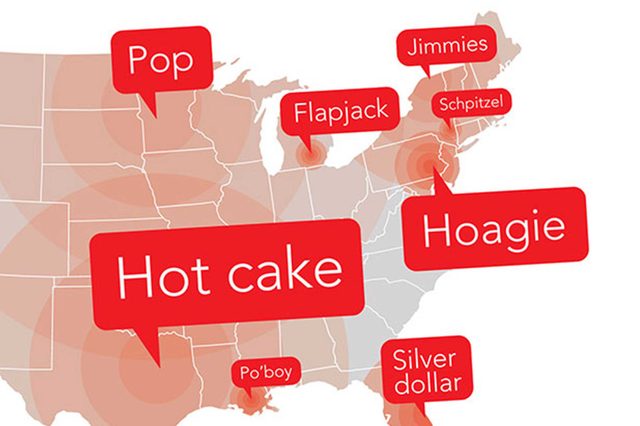
What’s your unique vocabulary?
When I’m thirsty at the office, I take a stroll over to the bubbler. What’s that, you ask? A drinking fountain, of course—if you live in the Midwest, or more specifically, in Wisconsin.
Even as the Internet connects people more and more, we still have unique vocabularies depending on where we live in the U.S. And that’s especially true when we’re talking about food! What you call certain staple dishes says everything about where you grew up (or where you live now).
So can we guess where you’re from based on these regional food words? Let’s find out!
Not related to food, say these 9 sayings and we’ll be able to tell you where you grew up.
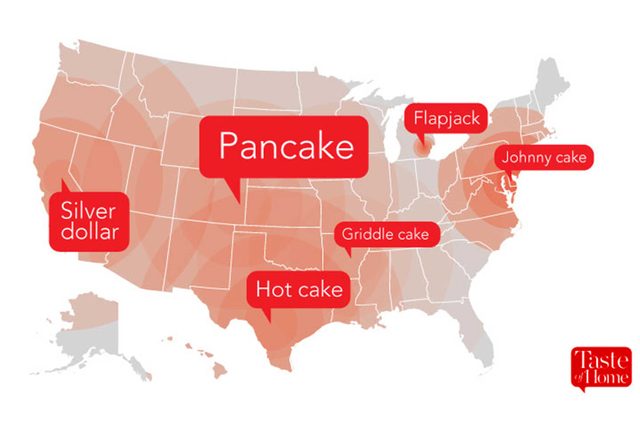
Pancakes, Anyone?
Most people call ’em pancakes, but there are tons of names for this classic breakfast item.
Flapjacks. We know this is an old term, since it appeared in Shakespeare’s Pericles, Prince of Tyre. Today, people in Michigan still use the term (ever been to the famous Flap Jack Shack?). The “flap” half of the name comes from the verb “flip,” but the second half, found in words like blackjack, lumberjack, or apple jacks, remains a mystery.
Griddle cakes or hotcakes. You’re likely from the south if you call ’em this. Northerners might never have heard these terms, but they’re so mainstream that McDonalds’ website refers to the popular breakfast menu item as “hotcakes with butter.”
Johnnycake. Officially, a johnnycake is a flatbread made from cornmeal, but people in the Carolinas and parts of New England use it for plain ol’ buttermilk pancakes, too.
Hoe cakes. Used in parts of Georgia, this moniker came from an old cooking method: Field workers used their hoes as makeshift griddles to fry up some cakes.
Some people also call them silver dollars, which is just a name for those mini pancakes roughly the size of the large American silver dollar coin. We might not use the coins anymore, but don’t worry: silver dollar pancakes are still as popular as ever! You can make them by reducing your batter to tablespoon-sized dollops on the griddle, or follow a pared-down recipe like this one.
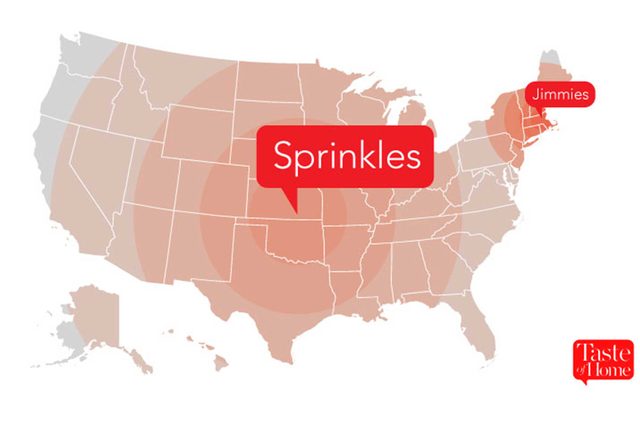
Everyone’s Favorite Dessert Topping
Asking for your ice cream “with jimmies” is a New England thing, but the term jimmies is actually universal. It’s a subgroup of the larger category of dessert toppings known as sprinkles, although people across the U.S. might use the terms incorrectly. Jimmies are actually cylindrical sprinkles, but some people use them to refer to only chocolate or only colored varieties. As for round sprinkles, they’re technically marketed as nonpareils. Does anyone call them that—or know how to pronounce it? Probably not.
In small sections of the East Coast, sprinkles might be referred to as hundreds and thousands as well, a term used in England that refers to the innumerable nature of these tiny little treats!
These are the best ice cream shops to go to in every state. Make sure you order jimmies if you’re in Massachusetts.
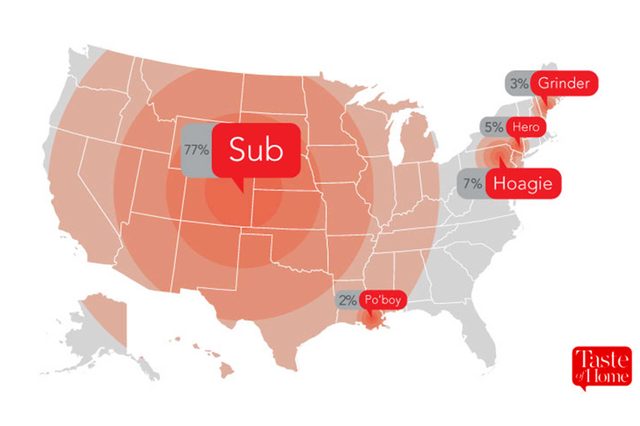
Cold Sandwich, Hot Debate
With the spread of Subway sandwich shops, most people have come to refer to a long sandwich as a sub, short for submarine sandwich. This should come as no surprise, since most synonyms for this word are derived from how the sandwich looks, but some of the names are a little harder to visualize!
Take hero, for example. In New York, a long sandwich is referred to as a hero because it’s so big, it takes a hero to eat it! Philadelphia, Pennsylvania, has its own term: hoagie. It probably started as a sandwich from the ’20s called a “hoggie” because it was so big you’d have to be a hog to eat one.
If you’re from New England, on the other hand, you might call this sandwich a grinder. That’s because it’s traditionally made from Italian bread, which has a thicker crust than your typical sandwich bread, making the whole thing tougher to chew, so you really have to grind to eat it.
Last, Louisiana is home to a poor boy sandwich – or po’boy. Why is it called that? Rumor has it that in 1929, when streetcar workers in New Orleans went on strike, the Martin brothers allowed any workers to come to their restaurant for free sandwiches. Whenever new customers walked in, they’d proclaim, “here comes another po’boy,” and the name stuck!
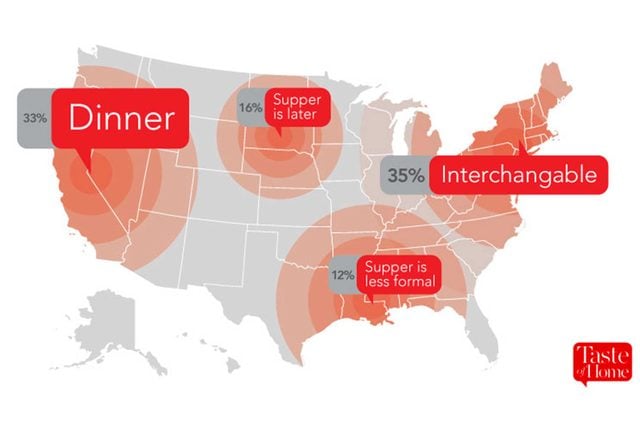
Ready for Supper?
If you thought supper was something they only said in other countries, you’re wrong. In parts of the U.S., this term is just about as popular as dinner. What it means, however, is up for debate.
Most people from the West Coast never say the word supper at all, using the term dinner to denote any meal after lunch. In parts of the South, supper is used primarily for dining at home, but dinner refers to a more formal meal eaten in a restaurant or someone else’s home.
In families with farming backgrounds, it was typical to eat a midafternoon dinner and then a late-night supper (as well as the usual breakfast and lunch) to fuel a long day of work. This four-meal schedule is rooted in traditions that have outlasted our agriculture roots, so people in the Dakotas or Nebraska still might refer to supper as an “after-dinner” meal.
Finally, Americans in the eastern region of the U.S. use supper and dinner interchangeably—even though their counterparts across the country might find differences between the two.
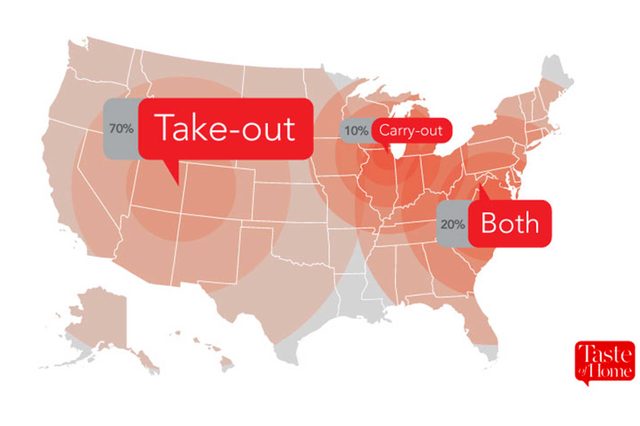
Food To-Go
If you call it takeout, you’re like 70 percent of Americans. If you call it carryout, you’re probably from the Midwest. And if you call it both names you’re probably from the East Coast.
We can’t decide what we want to call it… we’re too busy eating off the secret menu from our favorite Chinese takeout… er, carryout.
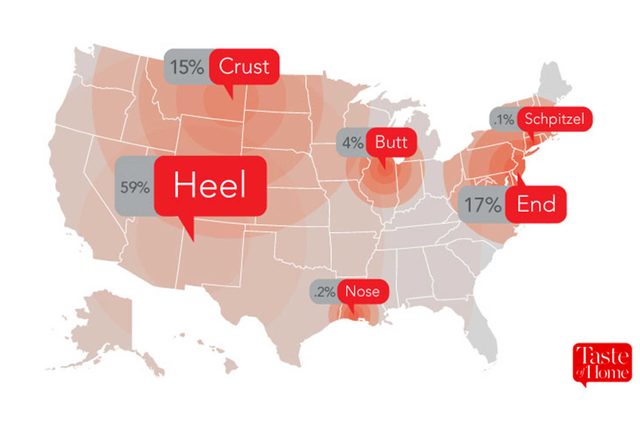
The Last Piece of Bread
Growing up, every friend I talked to at school had a different name for the last piece of bread. Like 4 percent of Americans (and some people from Chicago and Minnesota), we called it the butt. Around 60 percent of people call it the heel, but on the East Coast it’s referred to as just the end, and in the northern states just the crust. Even rarer are people who call it the shpitzel, a Yiddish word sometimes used by those from Connecticut or Delaware, or the nose, a southern Louisiana thing.
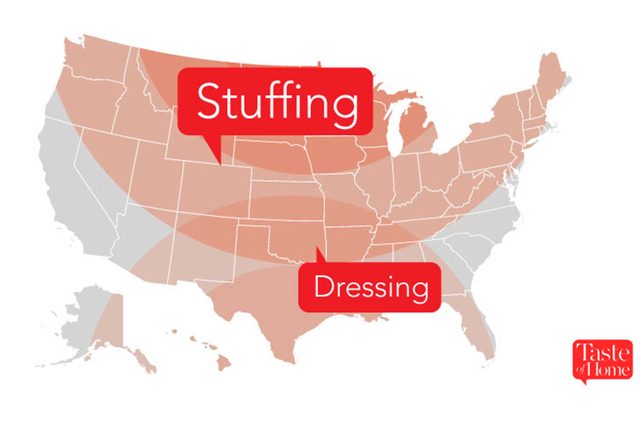
Stuffing Versus Dressing
If you even understand this question, you’re from the South. People from the North only know dressing as a liquid topping for salads, referring to stuffing as the thick mixture of seasoned breadcrumbs or croutons often used to fill chickens or turkeys. In the South, however, the term is known as dressing when it’s not inside a bird. There’s a name for stuffing that isn’t stuffing anything? Interesting.
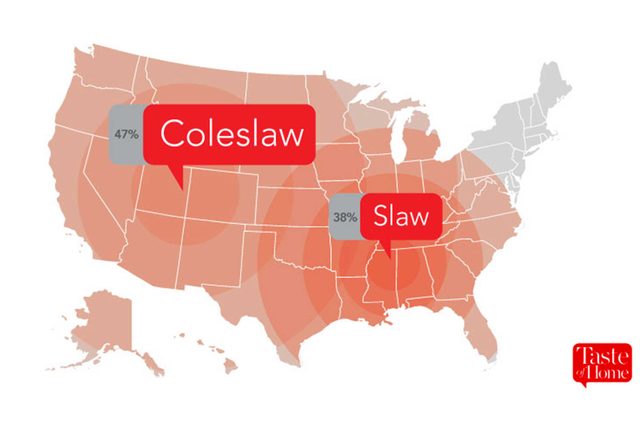
The Classic BBQ Side Dish
It goes great with grilled corn, BBQ ribs, and a buttery slice of cornbread. You know what we’re referring to: coleslaw! Or, if you’re from the South (especially North Carolina, Virginia, Kentucky, Tennessee, and Arkansas), just… slaw.
We used a dictionary to end this debate: coleslaw must contain cabbage while slaw can refer to anything prepared with the creamy mayonnaise sauce. If you’re just calling it slaw, you’re not wrong… but your friends in the northern U.S. are being a little bit more specific.
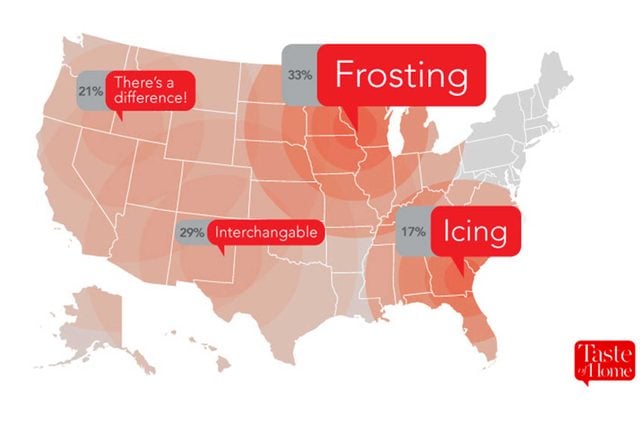
Not Quite a Piece of Cake…
Are icing and frosting different things? It depends who you ask.
Only around 20 percent of Americans know the difference. Frosting is a thick, creamy topping spread with a knife while icing is a thin, water-based coating drizzled or poured over sweets. Around a third of Americans use the words interchangeably, but certain regions only use one or the other.
For example, in the Southeast, both of these toppings are referred to as icing. In the North or Midwest, they’re both known as frosting.
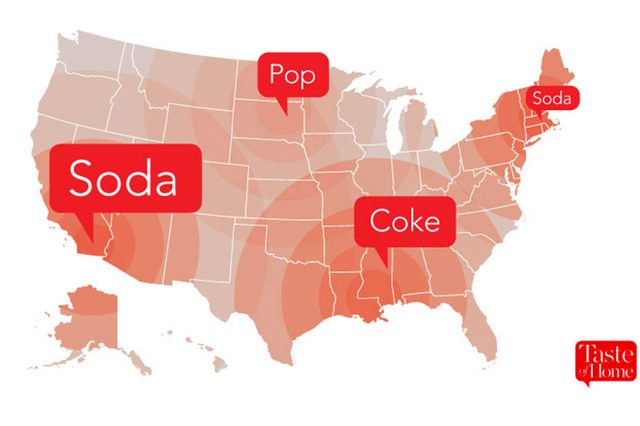
Last But Not Least…Pop or Soda?
One of the most heavily debated topics in food and drink, the word you use to describe a carbonated beverage differs from state to state. If you call it soda, you’re among the majority—most likely on the East Coast, the Illinois-Missouri border, southeastern Wisconsin, California, or surrounding areas.
If you call it pop, you’re probably from the Great Plains region or the Midwest. If you refer to it as coke or cola (regardless of whether it’s actually Coca Cola or something else, like Dr. Pepper!) you’re most likely from the South. (We still don’t get how you order a Sprite in those parts!)
Fun fact: These drinks are also commonly known as soft drinks because they don’t contain alcohol, a hard drink! Whatever you call your favorite fizzy drink, someone will probably be around to tell you that you’re saying it wrong. Of course, you’re also probably saying these 70 words and phrases wrong too.